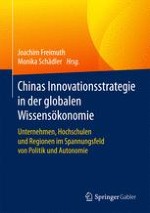2017 | OriginalPaper | Buchkapitel
3. Innovationskultur und Innovationssysteme in China
verfasst von : Christian Göbel
Erschienen in: Chinas Innovationsstrategie in der globalen Wissensökonomie
Verlag: Springer Fachmedien Wiesbaden
Aktivieren Sie unsere intelligente Suche, um passende Fachinhalte oder Patente zu finden.
Wählen Sie Textabschnitte aus um mit Künstlicher Intelligenz passenden Patente zu finden. powered by
Markieren Sie Textabschnitte, um KI-gestützt weitere passende Inhalte zu finden. powered by
